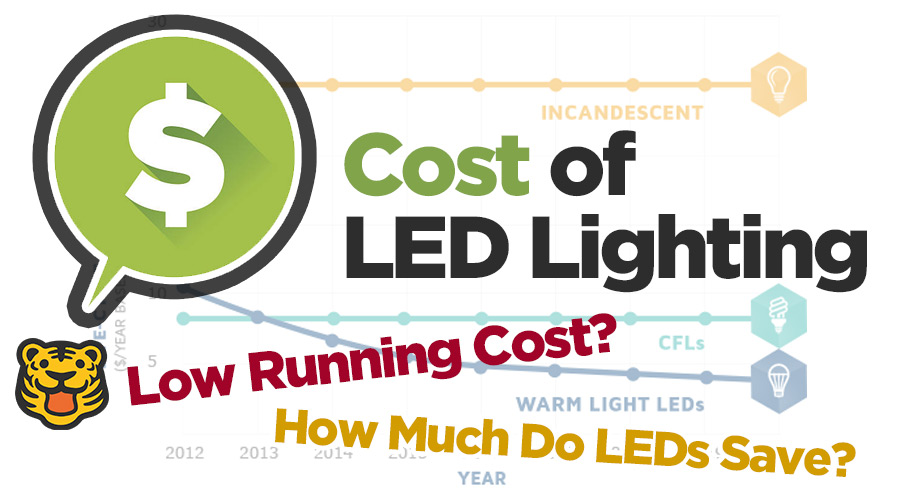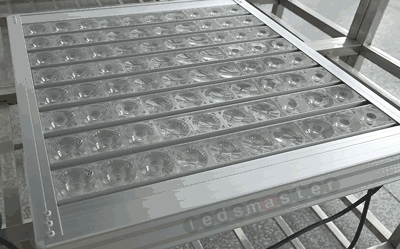Cost of LED Lights and its Running Cost – Telling You the Facts About LED

Lighting is responsible for taking up quite a good share of electricity consumption. In larger utilities e.g. companies and factories, the cost of day-to-day lighting is large and can’t be neglected, and thus LED lights are the most popular alternative when it comes to HID replacement. The maintenance and running cost of LEDs are much lower than the traditional lighting. Since the light is something indispensable with, looking for more energy efficient ways to get it is worth the try as it pays off sooner or later.
Energy saving is a real and vital process that pays back to the individual himself before the environment. People keep trying to find better sources for their use of energy and by better they don’t only mean safer for the environment but also more affordable and efficient for the consumer. Imagine spending less money on heating and electricity for example without lowering your usual consumption. In this article we are going to share with you the cost of LED lights.
LED Lights Replacement Saves Your Cost
LED lamps have got a good popularity over the past decade. From serving as small spotlights to the currently used anywhere and for all-purpose bulbs, the market od LED lamps is increasing sharply and expected to still grow for years to come. Why are they becoming more popular? The simplest direct answer is: by saving more money. A normal consumer always looks for good quality in exchange for a good price and that’s what LED bulbs present.
1. High Life Span of LED Reduces Replacement Frequency
First of all, LEDs are more durable than any other source of lighting. While the estimated life span of a LED is more than 80000 hours, compact florescent lamps CFLs last for only 8000 hours. Not to mention the short-term incandescent which go on for only 1000 hours. This means that LEDs keep working 10000 days more than its close contestant i.e. about 27 years. Likewise, you might need to change a normal incandescent bulb 80 times for every single time you change an LED.
2. Low Running Cost of LED Light Bulbs
The running cost of any other source of lighting outweighs LEDs. So, there is no doubt that in the long run, they are more effective and money-saving. Another non-negligible aspect is the energy consumption, if you are using one incandescent lamp for 8 hours a day for 2 years, this will cost you about $50, but if you’re using a LED for the same period -8 hours for 2 years- this will cost you as low as $2 to $4. How much can we save? You can save at most $48 per year, and $4 per month for each LED light you use. We’re talking about one single bulb here. In any household or utility where there’re always multiple bulbs turned on for longer hours of the day the difference in cost is really worth consideration. Yes, LEDs come for a bigger purchase price, but the overall cost is way less than other types of lamps and the price keeps decreasing over the time. It’s just that technology comes often at higher prices till the market fully accommodates it then the cost of its production goes down.
Why Should We Replace to LED Lights?
1. Instant On & Off
 In addition to being highly energy-efficient, LED lamps have many other advantages over other types of lighting such as metal halide, incandescent and fluorescent. They start immediately and don’t take much warm-up time as florescent ones. There’s no problem in turning them on and off frequently. It doesn’t affect their performance or life span. They also don’t break easily unlike CFLs and incandescent lights as the material used to manufacture them is solid state one with no tubes or filaments to break. Hence, LEDs are durable and non-fragile.
In addition to being highly energy-efficient, LED lamps have many other advantages over other types of lighting such as metal halide, incandescent and fluorescent. They start immediately and don’t take much warm-up time as florescent ones. There’s no problem in turning them on and off frequently. It doesn’t affect their performance or life span. They also don’t break easily unlike CFLs and incandescent lights as the material used to manufacture them is solid state one with no tubes or filaments to break. Hence, LEDs are durable and non-fragile.
2. Less Heat Generation
Most traditional lighting sources convert a large part of its energy consumption into heat. LEDs, on the contrary, produce less heat and zero ultraviolet rays making them a safer and healthier choice.
They are not affected by the temperature they operate in. Whether it’s 55°C outside or zero, a LED lamp will start up the same. There will be no noticeable degradation when they work in a very cold weather.
LEDs are small and fit in almost every design and every purpose. This could be a reason why their use expanded tremendously in a relatively short time. They come in multiple forms and options to match all needs.
Why LED is More Energy Saving?
LEDs have the capacity to direct the light, other sources simply don’t. You can direct the light of a LED in the direction you want. If you want it to illuminate the desk it will just do, whereas a florescent light, for example, will shed light on the desk, the ceiling and the wall behind you. The light will not be emitted as strong as desired but with a LED lamp, you only have it where you want. Consequently, you can make sure no energy is wasted and you get good illumination.
LED bulbs use only 2-15 watts of electricity which is very low if compared to the florescent or incandescent lamps. It’s estimated that these sources use up more electricity by at least 3-30 times. We’re talking about a decent sum of money saved by just shifting to the LED technology. They emit very little heat, thus maintaining energy consumption to a minimum and making sure this energy is used where needed “Light”, not in the form of wasted other forms. For all these reasons, LEDs are considered environmental-friendly. They don’t emit toxic substances or drag insects. No light or heat pollution is produced by them. The fact that they consume less energy itself is vital for the environment. Our planet will not tolerate the greedy behavior of the modern ages for long, so a LED lamp may be a little grateful contribution to our beloved mother nature.
In conclusion, LED lights are what you look for if you want to save money. You may spend some extra pennies in the beginning but believe me – and the statistics for that matter- it’s totally worth it. LEDs are easily applicable everywhere. You can find products to be inserted instead of other traditional lights without any need of specific arrangement. LED lights are currently the smartest choice as regards lighting options. Still thinking yet?